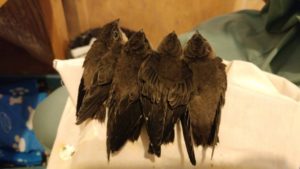What is the NRMP?
Since 2013, our core volunteer monitoring participatory program has been via the National Roost Monitoring Program (NRMP). The NRMP was initiated by Environment and Climate Change Canada (ECCC) in Quebec. The idea is that volunteers operate across provinces, monitoring roost chimneys on 4 set dates.
According to the methodology, a roost is 4 or more swifts recorded entering a chimney during the 30 minute period either side of sundown. We report these results to ECCC. Although many of our chimneys do not support a roost of 4 swifts, we still encourage volunteers to monitor as their chimneys during this period. The information we are generating from all our chimneys is building up an impressive picture of Chimney Swift distribution and behaviour in Manitoba. This IS critical information, so even if your chimney does not support larger numbers of swifts, your data is still very useful and very, very appreciated by MCSI.
When is it taking place in 2018?
Each monitoring period begins one hour before sundown and end usually 30 minutes afterwards, unless in those rare cases, the swifts remain outside the chimney after this period. In 2018, these dates are set as:
May 23rd
May 27th
May 31st
June 4th
MCSI would also like to add a couple of extra monitoring dates if possible, one before the NRMP on May 19th, and one after on June 8th. We would finish the roost monitoring season as well with our annual Swift Night out at Assiniboine School on June 12th.
What happened in 2017?
In 2018, MCSI will continue to support this program. In 2017, we did so by monitoring 55 sites in 11 communities in Manitoba, a phenomenal effort! You can look at our results at https://www.mbchimneyswift.com/Documents/NRMP20132017.pdf. For those interested in seeing how this fits in with the national picture, here are the results of the program, kindly provided by Céline Maurice at ECCC, and including results from BSC’s Maritime and Ontario Swiftwatch programs.
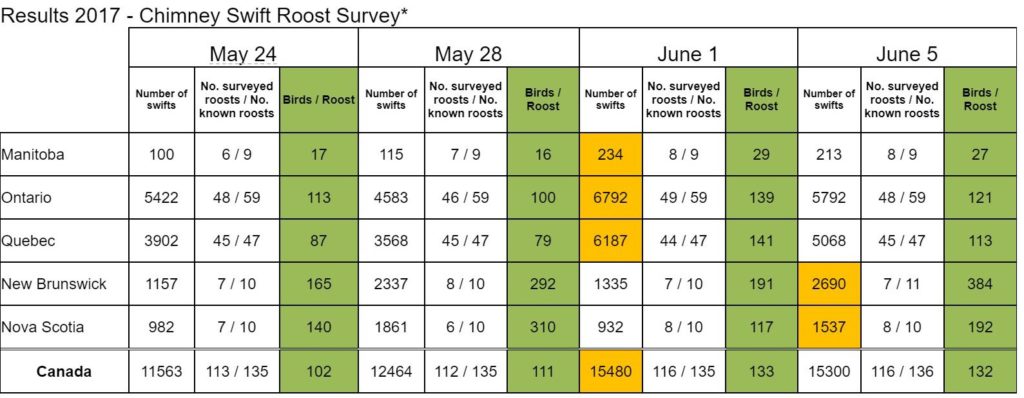 *: Data source: Bird Studies Canada, Manitoba Chimney Swift Initiative, Environment and Climate change Canada, Canadian Wildlife Service
*: Data source: Bird Studies Canada, Manitoba Chimney Swift Initiative, Environment and Climate change Canada, Canadian Wildlife Service
Data cannot be published without the agreement of these three organizations involved in data collection
Maximum number of swifts counted
http://www.mbchimneyswift.ca/index.html
http://www.oiseauxcanada.org/volunteer/ai/chsw/?lang=EN&targetpg=chswhelp
http://www.birdscanada.org/volunteer/ai/chsw/index.jsp?targetpg=chswabout
Data compiled by the Canadian Wildlife Service, Quebec Region, November 27, 2017
How and where can I get involved?
Turning to which roosts will need monitoring, we have 21 NRMP-qualified roosts on our databases. This means that 21 chimneys have previously supported 4 or more swifts during the NRMP survey. We have mapped them on Google, below, but for those who do not wish to work through that, here is a list of all the roosts, with the volunteer(s) we have assigned to this site in brackets. If you are unable to continue to monitor the chimney, if you let us know, we will endeavour to find a new volunteer to cover the site.
Here is the list:
Brandon – Orange Block (Margaret and Millie)
Dauphin – Main Street (Ken and Jan)
La Broquerie – Saint Joachim Church (David)
Otterburne – Providence (Frank and Jacquie, BUT, if any local volunteers can be found, please let us know)
Portage la Prairie – various, United Church and Victoria School (Gord)
Saint-Francois-Xavier – Michelle and Mike Tumber
Saint-Jean-Baptiste – Church (Luc)
Selkirk – Large stack (Selkirk Birdwatchers)
Souris – Murphy’s: An Irish Legacy (NO VOLUNTEER)
Steinbach – Bethesda Hospital (Keelie)
Winnipeg (City Centre) – 442 William (NO VOLUNTEER)
Winnipeg (City Centre) – 303 Assiniboine Avenue (John)
Winnipeg (Fort Garry) – Pembina Flag Shop (Badal)
Winnipeg (Fort Rouge) – 915 Corydon (Summer)
Winnipeg (Fort Rouge) – 517 Beresford (NO VOLUNTEER)
Winnipeg (Fort Rouge) – 321 Stradbrook (NO VOLUNTEER)
Winnipeg (River Heights) – 378 Academy (Kelly-Anne)
Winnipeg (St James) – Assiniboine School (Adolf, David, Jake, Anna, Beth)
Winnipeg (St James) – Moorgate Apartments, 2187 Portage (NO VOLUNTEER)
Winnipeg (St James) – Silver Heights Apartments, 2235 Portage (Valerie and Bob)
Winnipeg (St James) – St Ann’s Catholic Church, Hampton (Jenny)
https://drive.google.com/open?id=11jFUfg00up7j883K3mEVHfOPrag&usp=sharing
Of course there may be new roosts out there. We had a new fall roost in Winnipeg in 2017, which has been added to the list above. We aim to begin monitoring this site earlier than the set dates in 2018, to see if this is also a spring roost. I also have a suspicion about a site in the Wildwood area of Winnipeg if anyone is interested!
It would be amazing if we can keep the level of monitoring up in 2017. So please let us know if you are willing to take on a new site, and we will find a suitable site for you.
— Tim Poole
 MCSI are keen to help out any new volunteers and returning volunteers as you get going in 2018! For this reason, we will be hosting an early season swift count ahead of the first monitoring evening (which is on May 19th). The count will be held at Assiniboine School, 175 Winston Road, Winnipeg, on May 18th. We will be there to answer questions, demonstrate how to count swifts, and of course get a count for the evening. We will also hand out our new volunteer lanyards to any volunteer present (we can mail and deliver as well for those unable to come), data sheets, and factsheets.
MCSI are keen to help out any new volunteers and returning volunteers as you get going in 2018! For this reason, we will be hosting an early season swift count ahead of the first monitoring evening (which is on May 19th). The count will be held at Assiniboine School, 175 Winston Road, Winnipeg, on May 18th. We will be there to answer questions, demonstrate how to count swifts, and of course get a count for the evening. We will also hand out our new volunteer lanyards to any volunteer present (we can mail and deliver as well for those unable to come), data sheets, and factsheets. MCSI are keen to help out any new volunteers and returning volunteers as you get going in 2018! For this reason, we will be hosting an early season swift count ahead of the first monitoring evening (which is on May 19th). The count will be held at Assiniboine School, 175 Winston Road, Winnipeg, on May 18th. We will be there to answer questions, demonstrate how to count swifts, and of course get a count for the evening. We will also hand out our new volunteer lanyards to any volunteer present (we can mail and deliver as well for those unable to come), data sheets, and factsheets.
MCSI are keen to help out any new volunteers and returning volunteers as you get going in 2018! For this reason, we will be hosting an early season swift count ahead of the first monitoring evening (which is on May 19th). The count will be held at Assiniboine School, 175 Winston Road, Winnipeg, on May 18th. We will be there to answer questions, demonstrate how to count swifts, and of course get a count for the evening. We will also hand out our new volunteer lanyards to any volunteer present (we can mail and deliver as well for those unable to come), data sheets, and factsheets.
 In 2017, Marshall Birch, a former summer student with the Manitoba IBA Program, completed a GIS project with MCSI. For anyone not familiar with GIS, it stands for Geographical Information Systems. These are incredibly powerful computer modelling programs, and among their many uses, can be used to map information and use that information to build predictive models based on the information provided. In this case, Marshall was able to create a predictive model for Chimney Swift habitat in Manitoba. As part of his model, he estimated, based habitat and land-use information, where we might find Chimney Swifts in the Province of Manitoba. If anyone is interested, his report is posted on our website at
In 2017, Marshall Birch, a former summer student with the Manitoba IBA Program, completed a GIS project with MCSI. For anyone not familiar with GIS, it stands for Geographical Information Systems. These are incredibly powerful computer modelling programs, and among their many uses, can be used to map information and use that information to build predictive models based on the information provided. In this case, Marshall was able to create a predictive model for Chimney Swift habitat in Manitoba. As part of his model, he estimated, based habitat and land-use information, where we might find Chimney Swifts in the Province of Manitoba. If anyone is interested, his report is posted on our website at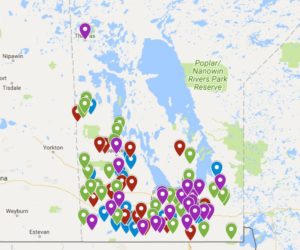
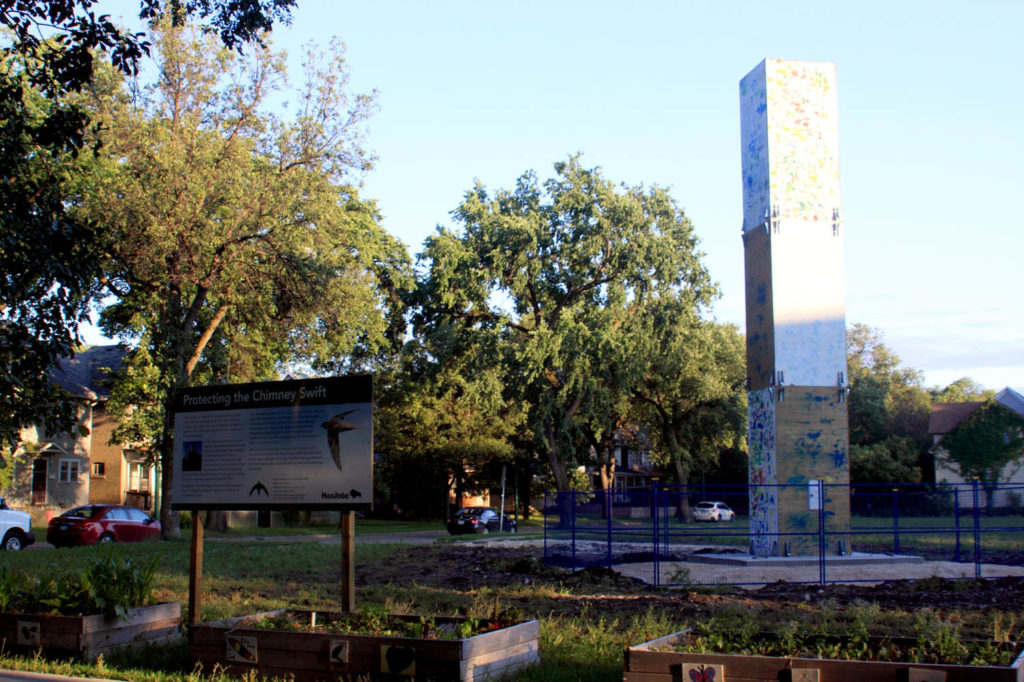
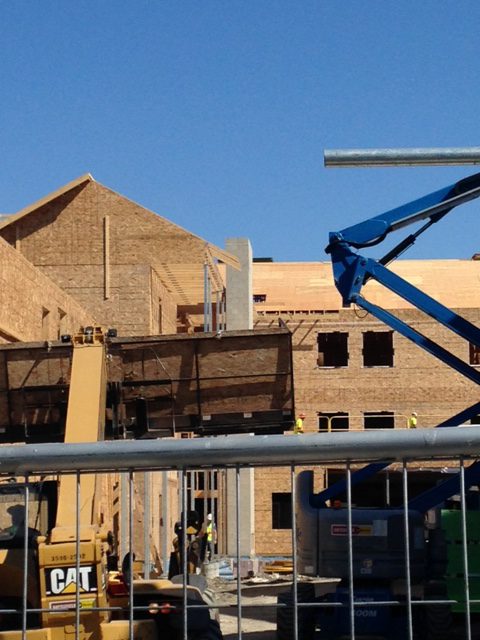
 Here is the crux – we need lots of help, as we would like to get as many days of monitoring covered on both these projects as possible. This would primarily be required during the roosting hour (half an hour either side of sundown). If you are able to help at any time from May 20th onwards, please contact Tim Poole at
Here is the crux – we need lots of help, as we would like to get as many days of monitoring covered on both these projects as possible. This would primarily be required during the roosting hour (half an hour either side of sundown). If you are able to help at any time from May 20th onwards, please contact Tim Poole at  In part 2 of our series of blogs on monitoring opportunities with MCSI in 2018, we are going to give a bit more information on doing other monitoring that you can do outside of the NRMP nights.
In part 2 of our series of blogs on monitoring opportunities with MCSI in 2018, we are going to give a bit more information on doing other monitoring that you can do outside of the NRMP nights. *: Data source: Bird Studies Canada, Manitoba Chimney Swift Initiative, Environment and Climate change Canada, Canadian Wildlife Service
*: Data source: Bird Studies Canada, Manitoba Chimney Swift Initiative, Environment and Climate change Canada, Canadian Wildlife Service As the warm brightness of March fades away, to be replaced by the cold starkness of April, I am sure that very few of us are thinking about Chimney Swifts! However, this is the perfect time to prepare for the arrival of our feathered friends, with just a month to go before the season kicks into gear.
As the warm brightness of March fades away, to be replaced by the cold starkness of April, I am sure that very few of us are thinking about Chimney Swifts! However, this is the perfect time to prepare for the arrival of our feathered friends, with just a month to go before the season kicks into gear.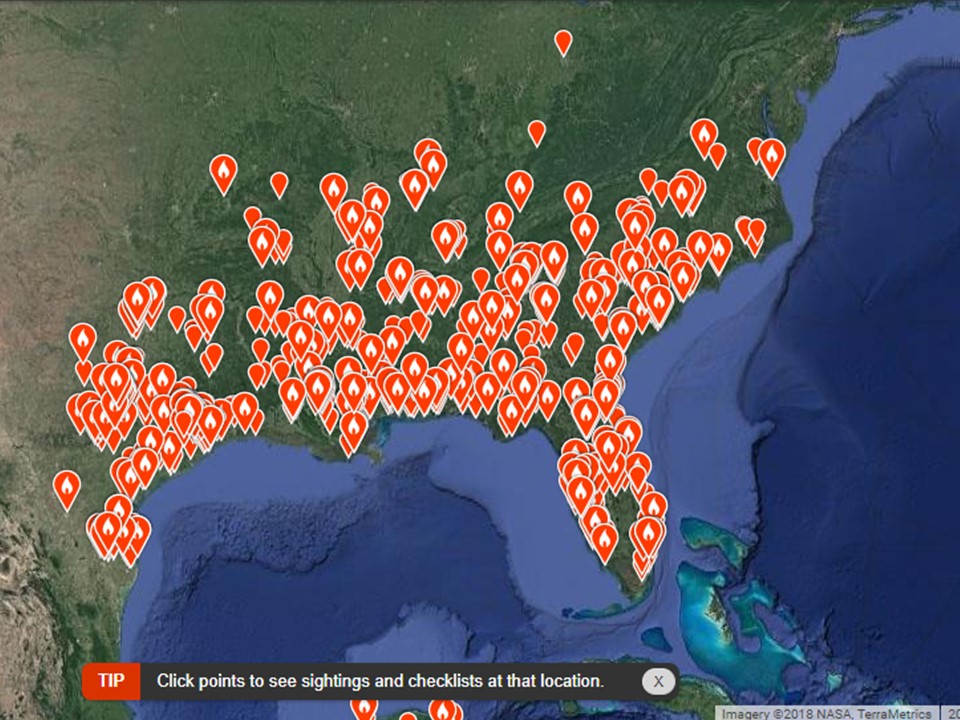 Finally, we have just checked the current migration status of Chimney Swift on eBird. Sightings are pretty widespread across the southeastern USA. The most northern record is in Ohio, and most northwesterly is in Arizona. However, and to no ones surprise, indications are that migration is currently in a
Finally, we have just checked the current migration status of Chimney Swift on eBird. Sightings are pretty widespread across the southeastern USA. The most northern record is in Ohio, and most northwesterly is in Arizona. However, and to no ones surprise, indications are that migration is currently in a 

